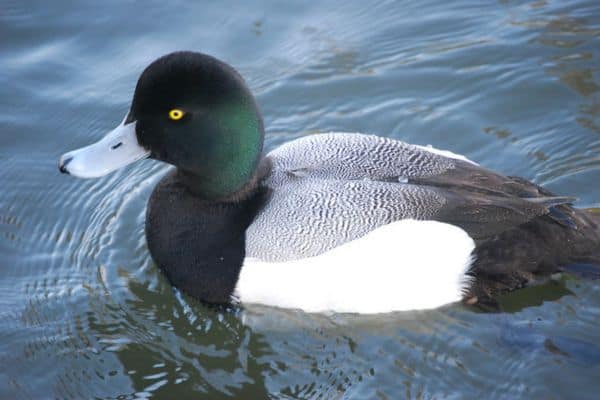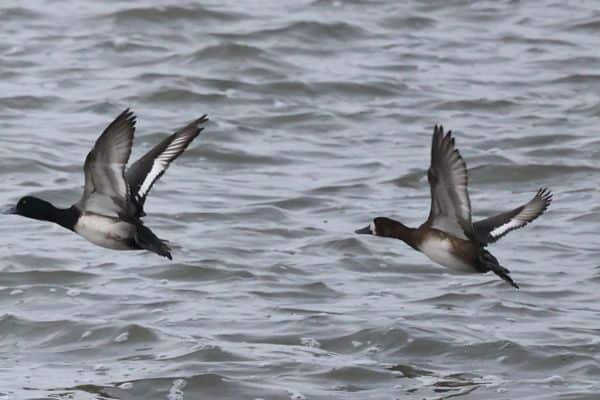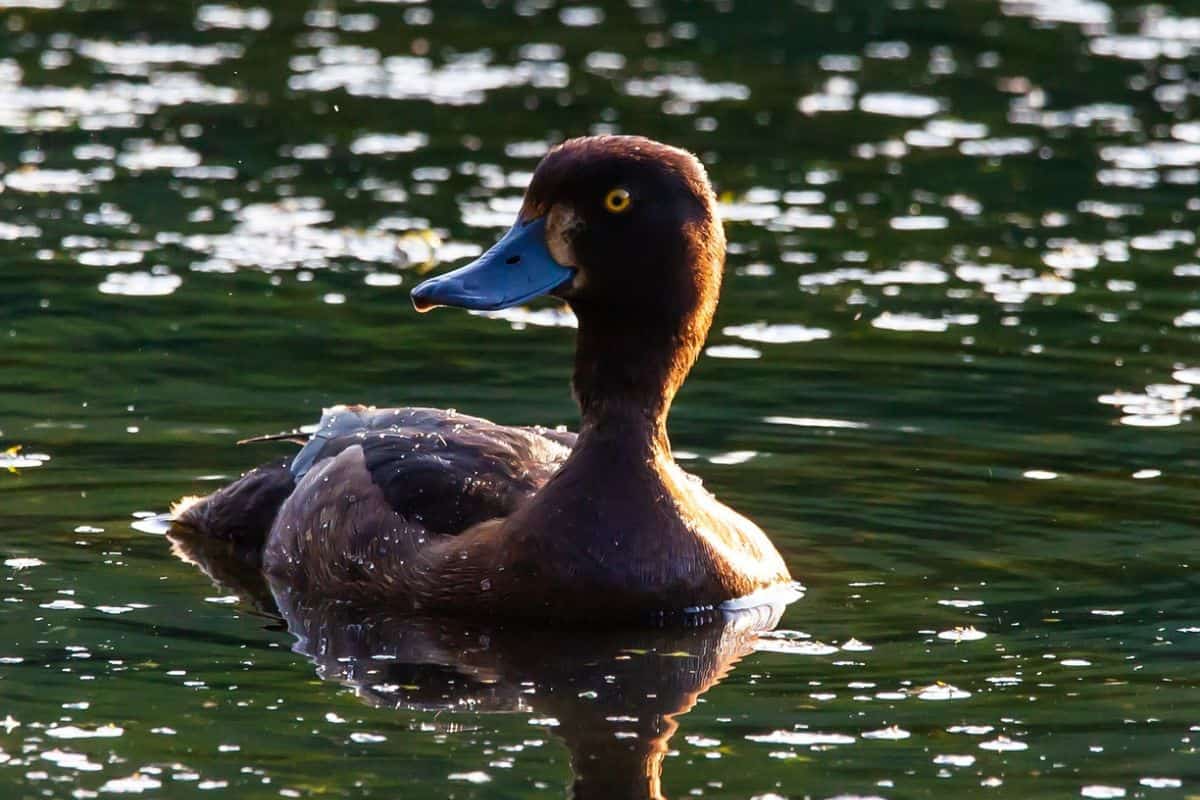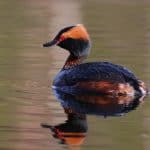Common Name: Greater Scaup
Scientific Name: Aythya marila| Size | Diet | Range in Hawaii | Status in Hawaii |
|---|---|---|---|
| 18 in. - 21 in. | insects, crustaceans, mollusks, and small aquatic invertebrates | Oahu and the Big Island | Least Concern |
The Greater Scaup, also known as Aythya marila, is a medium-sized diving duck that is found throughout North America and Eurasia. With its striking black and white plumage and bright yellow eyes, the Greater Scaup is a beautiful and fascinating bird to observe.
While it is most commonly found in northern regions, it has also been known to visit more southern areas during the winter months. Interestingly, the Greater Scaup has also been spotted in Hawaii, where it is considered a rare visitor. In this article, we’ll explore the world of the Greater Scaup and learn more about its existence in Hawaii.
Greater Scaup
Appearance

The Greater Scaup is a medium-sized diving duck known for its striking appearance. The male Greater Scaup has a glossy black head and neck, which contrasts with its white sides and back. Its breast and belly are black, and it has a light gray-blue bill with a black tip.
The female Greater Scaup, on the other hand, has a dark brown head and body with a paler face and a slightly lighter bill. Both male and female Greater Scaups have a bluish-gray beak that is broad and rounded.
Their eyes are golden-yellow, providing a vibrant touch to their overall appearance. Their feet are gray, and their legs are relatively short.
In terms of size, the Greater Scaup measures around 18-21 inches (45-53 cm) in length and typically weighs between 2-3 pounds (0.9-1.4 kg). They have a wingspan of approximately 32-37 inches (81-94 cm).
Diet
The Greater Scaup has a diverse and varied diet that mainly consists of aquatic organisms. These diving ducks are skilled foragers and spend a significant amount of time underwater in search of their preferred food sources.
The primary components of the Greater Scaup’s diet include a variety of aquatic invertebrates. They consume a wide range of small animals such as insects, crustaceans, mollusks, and small aquatic invertebrates.
Bivalves like clams and mussels are particularly favored by Greater Scaups, and they possess the ability to crush the shells with their strong bills. In addition to invertebrates, the Greater Scaup also incorporates plant matter into its diet.
They consume various aquatic plants, seeds, and sometimes even small fish. This adaptability allows them to exploit available food resources in their habitat effectively.
The Greater Scaup’s diet reflects its ability to thrive in both freshwater and marine environments. By feeding on a combination of animal and plant matter, they maintain a balanced and nutrient-rich diet that supports their energy requirements.
Nesting
The Greater Scaup follows a relatively simple nesting pattern. They typically breed in the northern parts of North America and Eurasia, often choosing areas with extensive wetlands, marshes, or lakeshores as their nesting sites.
The female Greater Scaup constructs the nest, which is typically located on the ground near water, such as on a raised mound or in dense vegetation. The nest is built using a variety of plant materials, including grasses, reeds, and twigs. The female creates a shallow depression in the nest and lines it with down feathers to provide insulation and comfort for the eggs.
Greater Scaups are monogamous during the breeding season. The male accompanies the female during courtship, and once a pair bond is formed, they mate. The female then lays a clutch of around 7-10 eggs, although the exact number can vary. The eggs are usually pale green or olive in color.
Once the eggs are laid, the female incubates them for about 25-29 days. During this period, she remains dedicated to keeping the eggs warm and protected. The male may leave the nesting area and gather with other males in groups known as “rafts” in nearby waters.
After the incubation period, the eggs hatch, and the fluffy young, called ducklings, emerge. The female leads the ducklings to the water, where they can feed and grow. The young scaups are capable of swimming and finding their own food shortly after hatching but still rely on their mother for protection and guidance.
The nesting season of the Greater Scaup is relatively short, as they migrate to wintering grounds in coastal areas or large bodies of water after the breeding season. This nesting strategy ensures the survival and continuation of their species in suitable habitats during the breeding season.
Behavior

The Greater Scaup exhibits fascinating behaviors that contribute to their adaptability and survival in their respective habitats. These diving ducks are known for their exceptional diving abilities, spending considerable time underwater in search of food.
With their strong legs and webbed feet, they navigate underwater depths to locate and capture their prey. Their diving proficiency allows them to access a diverse range of aquatic organisms. In terms of social behavior, Greater Scaups often gather in large flocks, particularly during migration and wintering periods.
These flocks, called “rafts,” can consist of numerous individuals, sometimes numbering in the hundreds or even thousands. Within these congregations, they demonstrate cooperative behaviors, such as synchronized movements and coordinated foraging.
This social structure provides them with added protection, as they can collectively spot predators and react quickly to potential threats. During the breeding season, Greater Scaups exhibit monogamous behavior, forming pairs that remain together until their chicks fledge.
The female constructs the nest, usually on the ground near water, using plant materials and lining it with down feathers for insulation. Once the eggs are laid, the female diligently incubates them while the male may join other males in nearby waters.
After hatching, the female leads the young ducklings to water, where they develop their swimming and foraging skills under her guidance and protection. Greater Scaups are also known for their migratory nature, undertaking long-distance journeys between their breeding and wintering grounds.
They navigate these migrations with remarkable precision, utilizing celestial cues, landmarks, and even Earth’s magnetic field to guide their way. These migratory patterns enable them to access different food sources and suitable habitats throughout the year.
Habitat
The Greater Scaup is a diving duck that thrives in a diverse range of aquatic habitats. These ducks are primarily found in the northern regions of North America, Europe, and Asia. They have a broad habitat range that encompasses wetlands, marshes, lakes, reservoirs, coastal areas, and even inland waterways.
In wetland environments, such as freshwater marshes, ponds, and lakes, Greater Scaups are frequently observed. They are attracted to areas with abundant emergent vegetation and aquatic plants.
These wetland habitats not only provide suitable nesting sites for the scaups but also offer a plentiful supply of food resources, allowing them to dive and forage for their preferred prey. Larger bodies of water, such as lakes and reservoirs, are also preferred habitats for Greater Scaups.
They are particularly drawn to open water areas with submerged vegetation and shallow depths that enable their diving behavior. These habitats offer the scaups ample opportunities to find and capture their prey, ensuring their dietary needs are met.
During the winter months, Greater Scaups migrate to coastal regions. They seek out estuaries, bays, and open coastlines, where they can find a mix of saltwater and freshwater habitats. These coastal areas provide a diverse range of food sources, including mollusks and small fish, which sustain the scaups during the non-breeding season.
In addition to wetlands, lakes, reservoirs, and coastal areas, Greater Scaups can also be observed in inland waterways, especially larger rivers connected to suitable wetland or coastal habitats. They are adaptable to a variety of aquatic environments and utilize these habitats for feeding, resting, and during migration.
Range
According to the Hawaii Bird Project, the Greater Scaup is a rare visitor to Hawaii, with sightings reported on several of the islands, including Oahu and the Big Island. The bird is believed to be a vagrant, or individual that has strayed from its normal range, and is not an established resident of the islands. Sightings of the Greater Scaup in Hawaii are infrequent and unpredictable, with the majority occurring during the winter months.
Conservation Status

The conservation status of the Greater Scaup is currently of concern, as their population has experienced declines in certain regions. While the species is not globally threatened, certain local populations have faced challenges. In North America, Greater Scaups are listed as a species of “Least Concern” by the International Union for Conservation of Nature (IUCN).
However, specific subpopulations, such as the Pacific Flyway population, have shown declines and are considered a “Species of Moderate Concern” by the North American Waterfowl Management Plan. Threats to the Greater Scaup include habitat degradation and loss due to human activities, including wetland drainage and development.
Pollution, such as oil spills, can also have detrimental effects on their habitat and food sources. Climate change and its impacts on breeding and wintering habitats are also emerging concerns.
Interesting Facts
1. They are Diving Experts
Greater Scaups are exceptional divers and can plunge to depths of up to 23 feet (7 meters) in search of food. They have the ability to stay submerged for around 20-30 seconds.
2. Monogamous Breeding
During the breeding season, Greater Scaups form monogamous pairs that remain together until their chicks fledge. The female constructs the nest, incubates the eggs, and leads the ducklings to water after hatching.
3. Impressive Migrations
Greater Scaups undertake extensive migrations, with some individuals traveling thousands of miles between breeding and wintering grounds. They navigate using celestial cues, landmarks, and Earth’s magnetic field.
4. Cooperative Foraging
Greater Scaups often form large flocks, known as “rafts,” during migration and wintering periods. Within these flocks, they exhibit cooperative behaviors, such as synchronized movements and coordinated foraging.
5. Vocalizations
Greater Scaups communicate using a variety of calls, including low grunting sounds and soft whistles. Males often produce a distinctive “scaup” call during courtship displays.
Frequently Asked Questions
1. What is the lifespan of a Greater Scaup?
The average lifespan of a Greater Scaup is around 10 to 12 years. However, some individuals have been known to live up to 15 years or more in the wild.
2. Do Greater Scaups have any predators?
Greater Scaups face predation threats from various predators, including large birds of prey such as eagles and hawks. Additionally, some mammalian predators, such as foxes, raccoons, and mink, may target their nests or young ducklings.
3. Are Greater Scaups considered a game bird for hunting?
Yes, Greater Scaups are considered a game bird in certain regions and are legally hunted for sport and sustenance. Hunting regulations and bag limits are usually in place to ensure sustainable hunting practices.
4. Do Greater Scaups have any unique courtship displays?
Yes, during courtship, male Greater Scaups engage in elaborate displays. These displays often involve head-throwing movements, wing-flapping, and head-bobbing, accompanied by vocalizations. These behaviors are intended to attract and impress females.




